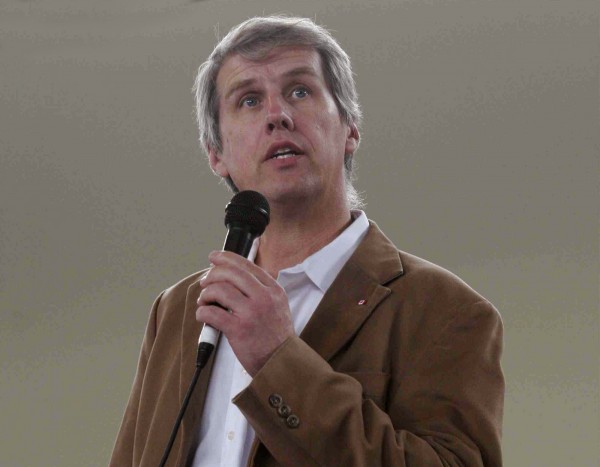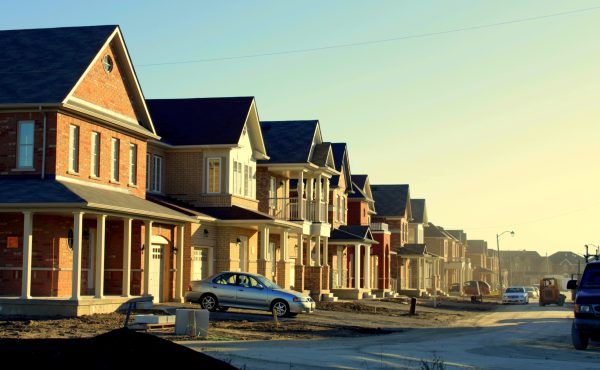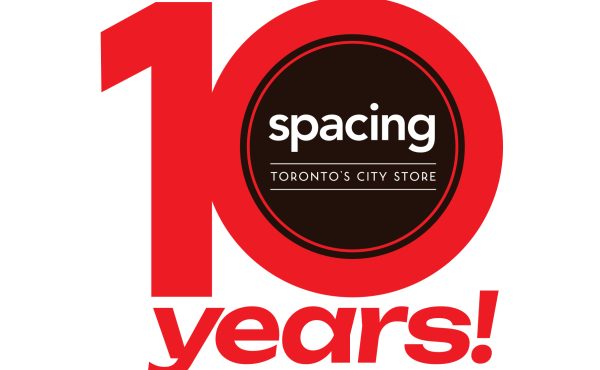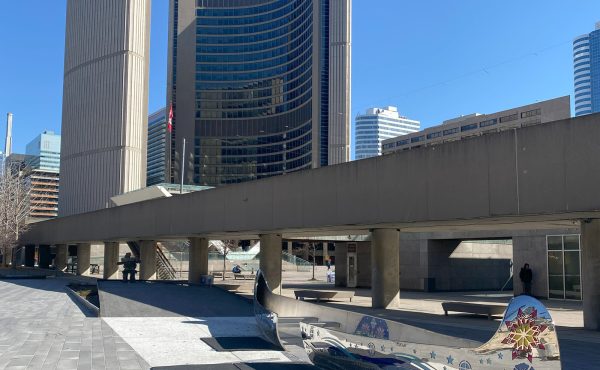Hello, viewers out there. It’s time for yet another installment of…. (drum roll)… “Let’s Make A Decision!” with your co-hosts Rob Ford and Karen Stintz. This week, riders get to spin the magic transit wheel to see who wins and who loses, and compete for cash and prizes…
Oh, sorry. Was my cynicism showing? I’ll try to cover up next time.
To a naïve observer, this week’s city council meeting — paradoxically, the latest in a series of final decisions about the use of the province’s $8.4 billion transit pot — may appear to have all the ingredients of a once-and-for-all type showdown over the future of rapid transit in Scarborough. There are three sharply competing visions for proposed routes, lots of cash on the barrel head, and a controversial financing proposal that should, in theory, force councillors to commit themselves.
Where have we seen this show before? And, come to think of it, when will we see it again? After all, city council no longer makes decisions. Rather, the politicians seem to believe they were sent to 100 Queen Street to unscramble the eggs.
It’s important to add, however, that the transit debacle of the past half-year is specifically symptomatic of the leadership void that has polluted local politics since Mayor Rob Ford was elected in 2010. To my mind, there’s a clear line connecting his election, the summary non-cancellation cancellation of Transit City, Gordon Chong’s absurd attempt to build a free subway, the three-part Stintz rebellion from the spring of 2012, and, finally, the nakedly political bid by Stintz and Scarborough’s Glenn deBaeraemaker to re-litigate Toronto’s signed contract with Metrolinx.
If we had a mayor who understood the role of coalition building and compromise, we’d be in a different place today. But, as the saying goes, power hates a vacuum, which is why you’re feeling so dizzy right now.
It’s hard to say how all this plays out during next fall’s election. Earlier this month, Ford’s first declared challenger, David Soknacki, entered the race. He comes armed with a somewhat confounding CV: a former Scarborough councillor who prefers the original LRT plan; a conservative who managed the cash during David Miller’s mayoralty; a businessman who believes the public sector has a role to play.
Most importantly, Soknacki is offering himself up as a no-drama facilitator-in-chief leader, a candidate in the mould of centrists like Alan Tonks and Art Eggleton. Spacing caught up to Soknacki earlier this month:
Spacing: Why do you want to run for mayor?
Soknacki: I’m running because I’d like to use my achievements in business and public life to make [Toronto] a better place for our residents, and to restore pride in our city.
Spacing: Do we have a problem with our sense of pride?
Soknacki: Although we are the envy of the world, we could be doing so much better. Council has the tools with which it can do pretty much everything it needs to do. Just look at the transit file. It doesn’t seem to be capable of making a decision. At the end of the day, it’s about building a city that works again, where city-building isn’t a dirty word. It’s more than just dealing with wedge issues in determining whether an issue moves forward. It’s about being able to take people’s hopes and aspirations and incorporate them rather than belittle them and drag them off into the fringes.
Spacing: Mayor Ford is a very polarizing figure. Some people love him, some people have a lot of concerns. Are you going to focus on the way he’s conducted himself?
Soknacki: No, my goal is to run my campaign. What I’m going to be doing is introducing policies and recommendations and ideas. It’s not to tear down what we’ve done but to say we can do better.
Spacing: You were the budget chair during the first part of Mayor David Miller’s term, during which the city’s overall budget grew quite substantially. Why should voters believe you when you say you were a good fiscal manager?
Soknacki: I’m proud of those budgets. If you take a look at those net budgets, you’ll see that a lot of the increases came from the province in supporting the hiring of transit workers, police, and not in the growth of overheads. What I introduced was the long-term fiscal plan that actually reduced taxes for businesses and tenants. We moved to a target of including two-thirds of council, not just 50% plus one. Although we may think that things like sidewalk shoveling or leaf collection aren’t important to downtowners, they’re important to the suburbanites, every bit as important as the subsidizing of recreation programs is to the downtown core.
Spacing: You’ve run a business for years. Do you think the private sector should be delivering more of the city’s services? Are there more opportunities besides waste collection, or should the city take stock and slow down with privatizing services?
Soknacki: There is a place for both private participation and public participation. For instance, private borrowers cannot borrow at a lower cost than the city can. There’s really no advantage of getting private investment for the sake of private investment.
On the other hand, take a look at what that outsourcing [of garbage collection] has done. Even beyond the cost savings, the level of complaints in the outsourced district has gone down. But the level of complaints has gone down in the in-house side as well. So my proposal on outsourcing is to take the current area that is now serviced by city workers, divide it in two, and send half of it out for bids, not only to the private sector but also to those inside. If we get a proposal that’s better value on both service and price, then outsource that and keep the fourth quarter in house.
Spacing: Let’s talk about revenue tools for transit. What’s your general view of the use of some of the tools proposed by Metrolinx as a way of raising capital for transit?
Soknacki: I think it is fair and appropriate to insist that there be a significant participation from our federal and provincial partners. At the same time, we as a city need to pay for part of that as well. I see the average household already pays hundreds of dollars a year in subsidizing transit. I see that we will need to continue to subsidize transit and we will need to figure out how to do so as long as we need transit.
Spacing: So you are in favour of revenue tools…?
Soknacki: You have to pay for transit. It’s not free. [But] I have difficulty with the proposition that the premier has to go to the voters of East Gwillimbury and ask them to raise taxes for transit in the City of Toronto.
Spacing: What should be the top transit priority for the Greater Toronto Area?
Soknacki: It’s carrying on with the Big Move and it is informed decision-making on what the next steps are.
Spacing: But if you’re the mayor, voters and my colleagues in the media will be asking you, what should we be building next?
Soknacki: If the demand and the real need is, for the sake of argument, for the Downtown Relief Line, then it needs to be the Downtown Relief Line.
Spacing: You sound like you haven’t been completely convinced.
Soknacki: Well, there is more than one project going on. I thought the Scarborough Extension LRT debate was done before we flipped and flopped and flipped and flopped and who knows where we are now. Then I thought the Sheppard LRT was put to bed, but apparently not any longer. Now what [TTC CEO Andy] Byford is saying is that the Downtown Relief Line is a priority. Those three ought to be the top priorities. At the same time, there’s an enormous investment in state of good repair. The City spends over half of its capital resources now just on upkeep and state of good repair. So what’s the next priority? If the funds are there, it could be, should be, something like the Dowtown Relief Line.
Spacing: Much has been said in recent years about the war between the downtown and the suburbs. Do you think that’s a real issue? And how are you going to go about heeling that rift?
Soknacki: It’s essential to look at communities and interests that may or may not have that downtown-suburban divide. So a priority community is a priority community whether it is in Rexdale, downtown or out in Scarborough. There’s no progress to be made by penalizing somebody for making a lifestyle choice. What we need to talk about instead is the value, for instance, of programming our recreational spaces.
The way I see it, rather than divide [the issue] into two — the core and the suburbs — it ought to be divided further into interests and needs. Then one could talk about housing policy across the city or community needs across the city, priority neighbourhoods across the city. In my mind, that’s a far more productive way of doing it rather than beating up somebody based on geography.
Spacing: Last question: when Ford ran in 2010, he pledged to eliminate the vehicle registration tax and the land transfer tax, and he opposed almost all other forms of tax increases. What’s your position? Should we keep the LTT and what should happen to property taxes?
Soknacki: The land transfer tax raises some $300 million. It would cause such distress to remove another $300 million from the city’s revenues. With respect to [property] taxes, I see them moving roughly at the rate of inflation, give or take a percentage.
Spacing: So you’re not going to promise a tax freeze?
Soknacki: Promising a tax free means causing so many inequities. What we see in growth in [municipal] areas with strong advocates, such as police and fire, and cuts everywhere else. It causes such distress.
Editor’s note: The complete interview transcript has been edited for length.





3 comments
I’d like to see Mr Soknacki be upfront about his tenure at Downsview Park. I think it’s fair to say it hasn’t delivered to anywhere like what was envisaged, and I got the impression (perhaps mistaken) that he got sidelined as time went on.
In response to a question about my tenure at Downsview Park
1. I was appointed as Chair for a period of five years. A few months after my term finished, the federal government decided to make the Park part of Canada Lands Corporation.
2. Our Board accomplished a great deal on many fronts during those five years: such as environmental sustainability, focusing on design excellence for the built form and finally getting the overall plan approved from ratepayer groups, Ottawa, City Hall and the OMB, plus financially endowing 363 acres for the public realm in perpetuity. Perfect? No. But substantial progress.
3. Examples of articles covering work of the Park Board and subsequent federal takeover can be found on my site (http://soknacki.com/news/default.php) or searching “Chris Hume” and “Downsview Park.”
David – especially in the low interest rate environment, the cost of capital for private companies can be lower than that for municipalities. This is because interest is a pre-tax expense for companies that are at least breaking even.
Furthermore, increasing municipal debt does not mean a linear increase in borrowing costs. As debt levels exceed ‘safe’ levels, a municipality’s boat rates increases – which impacts the cost of ALL its borrowing. In this case, municipal debt gets exceedingly expensive.